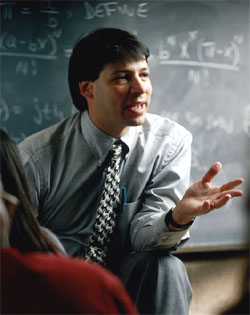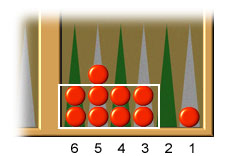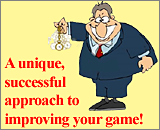
|
Professor Art Benjamin serves on the U.S. Backgammon Federation Board of Directors and chairs its Education Committee. He is a Professor of Mathematics at Harvey Mudd College. As an internationally famous "mathemagician," he has over 12 million views of his three TED talks, an appearance on The Colbert Report, and a book on the New York Times Bestseller list.
Because of his family, book writing, and performing, he doesn't get to travel to too many tournaments, but he maintains a great love for the game.
As you will read, Dr. Benjamin is truly a player that you can "count" on.
|

|
|
Please tell us where you grew up, a little about your family, your education, and your interests and hobbies as a child.
|
I grew up in Cleveland, Ohio, and graduated from a decent public school. My father was an accountant by day and a community theatre actor and director by night. My mother was a teacher and career counselor at a school for emotionally disturbed kids. She earned an advanced degree in Special Education to understand her very hyperactive son, me.
I was born in 1961 and people didn't understand ADHD kids too well back then. I was put on medication (Valium!) from about age 4 to age 13. As a kid, my passions were (and still are) games, puzzles, theatre, magic, and math.
In high school, I did magic shows for kids' birthday parties as "The Great Benjamini!" My goal was to become a professional magician or a Broadway lyricist. I was a very strong math student, and loved applying it to analyze games of chance, like backgammon.
I went to Carnegie Mellon University in Pittsburgh where I studied applied mathematics, then earned my PhD in Mathematical Sciences from Johns Hopkins University in Baltimore.
Along the way, I discovered how much I enjoyed teaching at the college level. The students seemed to really like the way I explained things, which I attribute to my years of performing magic for audiences.
|
Where do you live now and what is your daily life like?
|
Since 1989, I have been a professor of mathematics at Harvey Mudd College, in Claremont, California. HMC is a small private college with 800 students, all of whom major in math, science, or engineering. I love my work, my students, and colleagues.
|
Are you married? Any kids?
|
I met my wife Deena at Johns Hopkins.
We were married at the Magic Castle, in Hollywood, in 1993. We have two teenage daughters, Laurel and Ariel.
|
Tell us about your profession and anything you think is noteworthy or interesting.
|
My other full-time profession is public speaker, entertainer, and "mathemagician."
In college, I began combining my loves of math and magic to create a show in which I demonstrate and explain how to do math in your head faster than a calculator. I have performed this show thousands of times (about 100 shows per year), and it's part of my life goal of bringing math to the masses.

I have given three TED talks, which have been viewed over 12 million times, and I appeared on The Colbert Report in 2010. I have written several books, the most popular of which has been Secrets of Mental Math and my newest book, The Magic of Math: Solving for x and Figuring Out Why.
I am pleased to say that my new book made the New York Times Bestseller List for Education books in September. I have also created four DVD courses for The Great Courses, one of which is on The Mathematics of Games and Puzzles.
|
What else are you really good at besides backgammon? Have you won any titles, awards, or distinctions in those areas?
|
I was captain of my high school chess team and I studied the game pretty seriously then. I played in some tournaments, but my rating never went above 1800.
|
It doesn't seem to me that math plays much of a part in chess. Do the same mental abilities required for math also apply in some way to chess?
|
The games are similar in that you look ahead to visualize the anticipated flow of the game, but I agree that there is no arithmetic in chess (which is probably why I prefer backgammon). Also the games do not require you to remember what happened previous to the current position. You can be an absent-minded, distractible person and still do well in both games. I'm a mediocre bridge player because I sometimes forget which cards have been played.
|
How did you get involved in backgammon?
|
I think it was around 1974. I was in junior high school and my mother came home one day and said that she saw a backgammon table at someone's home. She said that it was so beautiful that she would even learn to play the game.
This got me very excited, because she was not a game player.
So I got some books from our library and learned how to play. And since I learned backgammon strategy right off the bat, I was a better player than all of my peers.
I read Paul Magriel's book in high school and anything else I could find. I played in my first local tournaments in college with the Pittsburgh Backgammon Association and in grad school with the College Park Backgammon Club in Maryland.
I was still an intermediate player back then, but I studied the game a lot. My first big tournaments were in Los Angeles and Las Vegas starting around 1990.
|
What is your favorite backgammon book of all time?
|
In grad school, I learned a ton from Bill Robertie's books on Advanced Backgammon.
|
What trophies or awards have you won in the ABT or elsewhere?
|
In the 1990s, I got very serious about the game and did very well in tournaments in Los Angeles, Reno, Vegas, and especially San Diego. The ABT began in 1993, just as I began an incredible winning streak in the San Diego regional tournaments.
I cashed in seven straight tournaments, winning first, second, third, fifth, first, first, and first. I was in the top eight of the The ABT every year from 1993 to 1997, finishing second in 1993, third in 1996, and first in 1997, when I won in San Diego and Michigan. I was the all-time points leader for the ABT for many years, and I'm still number 9 on the all-time list, even though I have won very few points since 1998.
What happened in 1998? Laurel was born that year, and I knew that life would have to change to make time for being a dad. I played much less backgammon after that. I also became much busier as a mathematician, author, and public speaker.
|
Have you been using computer programs such as Snowie and XG? Do you have strong computer skills and a good understanding of the bots?
|
I'm afraid I started to slow down my studying of backgammon just as computers were starting to get really good. I enjoy playing against and learning from XG, but I have not yet had the time to study the game as intensely as I would like.
|
What particular traits do you have that make you a strong backgammon player?
|
I'm not afraid to do math over the board. I may not be one of the strongest players around, but I'll put my pip counting skills against anyone.
|
You are indeed a very fast pip counter. Do you use Jack Kissane's Cluster Counting or have you developed a method of your own? Help us out here.
|
Although I developed my pip counting methods independently, they are very similar to Jack's cluster counting method. Here are some of the main ideas.
- Count the pips horizontally instead of vertically. For example, if your inner board has two checkers on the six, four, and three points, three checkers on the five point, and one checker on the one point, then I first count the two layers of checkers on the three, four, five, and six point, which is 2 × 18 = 36 pips, then add an extra checker on the five and one points for a grand total of 42 pips.

- If you have two checkers apiece on the seven and eight points, that's an instant 30. Two checkers apiece on the eight and nine points is an instant 34.
- For checkers in your opponent's home board, the count is 20 times the number of checkers plus adjustment from the five point. For example, if you have two checkers on the 20 point, and one checker apiece on the 23 and 24 points, then I count (4 × 20) + 3 + 4 = 87 pips.
I once had the pleasure of playing Jack at a tournament and we had fun counting the positions that arose in practically the same time. He recognized more clusters than I did, but I was quicker at the raw number crunching.
|
Are there any other math shortcuts you have developed for backgammon? For example, I don't find it very easy to divide by 1296.
|
Just divide by 13. For example 310/1296 is essentially 310/13 percent. 13 goes into 310 twenty times, with a remainder of 50, and 50 divided by 13 is close to 4, so 310/1296 is about 24%. To get more practice dividing by 13 and other numbers, see my book Secrets of Mental Math.
|
Have you ever thought about writing a book or pamphlet on the math of backgammon?
I'd sure buy a copy if you did.
|
That's a good idea. I'll add it to my bucket list!
|
Have you memorized all of the take points and the match equities for a typical 13 point match, and if not, how do you figure them out over the board?
|
I use a phonetic code called the major system, where every digit gets a consonant sound. It has been in the English language for over 200 years, and it's explained in my book.
Briefly, here it is: 1 = T or D; 2 = N; 3 = M; 4 = R; 5 = L; 6 = CH, SH, or J; 7 = K or G; 8 = F or V; 9 = P or B; 0 = S or Z. By inserting vowel sounds, you can turn numbers into words. For example, 12 = TINY and 68 = SHOVE.
When the score is 1-away 2-away, the leader has a 68% chance of winning the match. I encode this by remembering TINY SHOVE. Similarly, 1-away 3-away gives the leader 75%, which I store as DIME CALL. I use this to memorize the equities up through a 9 point match.
|
Do you think it is possible to become a top player without excellent math skills? Can players become great by visual skills, or feel, or experience?
|
Yes, you can often substitute math with memory or rules of thumb. For instance, you know instinctively that there are more ways to hit a checker that is 5 or 6 away than when it is 1 or 2 away.
Except for counting pips, I probably only calculate once or twice per game, on average. Most of the game is just applying sound principles (which are based on mathematics or reference positions).
|
What recommendations would you give to an intermediate player to help him become a top championship player?
|
Play against the computer a lot, and learn from your mistakes. Eventually you will get a feeling for the right time to double or take.
|
What are your future plans for tournaments next year, and the following years?
|
I'll have to wait five more years until both of my kids are in college before I can travel to many tournaments. My brother Stephen still lives in the Cleveland area, and he is a very strong player. I hope we can play doubles together in Ohio, Pittsburgh, or Michigan someday soon.
|
Who are your heroes in backgammon, the people you look up to both as players and leaders?
|
I recommend everything written by Bill Robertie, Kit Woolsey, Walter Trice, and Jeremy Bagai. I am also extremely grateful to Patrick Gibson for singlehandedly sustaining the backgammon community here in Southern California.
|
What are your pet peeves about tournaments and tournament play?
|
In a double elimination tournament, I think that the winner of the consolation bracket should only have to beat the undefeated winner once, instead of twice, to win the tournament. The winner of the consolation bracket typically must defy the same sort of odds to make it to the finals. Who would you rather bet on? The player with a 6–0 record or the player with the 8–1 record?
Not so clear. And if the 8–1 player beats the 6–0 player in the finals match, then who deserves first place? I would say the 9–1 player (especially since he just beat the 6–1 player)! To make them play one more match just prolongs the tournament. Some directors have adopted this suggestion, and I wish more would do so.
|
Any thoughts about what the USBGF or other backgammon federations should do to popularize the game?
|
I am a proud member of the Board of Directors of the USBGF and serve as chair of the Education Committee. For the last few years, I have run backgammon workshops, minicourses, tournaments, and social events at some of the national collegiate mathematics meetings.
I would like to see us attract more college students to the game. I would like to update our online materials, and streamline the educational materials that we offer to students and teachers. I am very proud of what the USBGF has accomplished in a short period of time and I am excited to see how it evolves in the future.
|
What do you think about the subject of teaching backgammon to young children and school children?
|
That's a tricky question because of the gambling nature of the game. On the other hand, people tend to have more time and desire to play games when they are young, and the game can be enjoyed without bringing money into it, just as people do with games like chess and bridge. Besides, the more you know about the math behind games of chance, the less likely you are to be attracted to casino games.
I can't think of any other game where knowing just a little bit of math goes such a long way. I think backgammon promotes logical and analytical skills. I am fine with teaching backgammon to high school students.
|
What are your plans for the future? What you would like your life to look like 10 years from now?
|
In 10 years, I expect to be retired from teaching, and my kids will be grown, so I hope to be playing a lot more backgammon!
|





